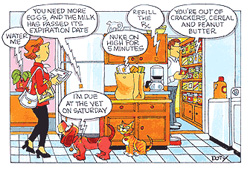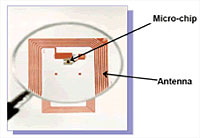Tag, You're It - Tomorrow's ID Is An RFID
 High-resolution version of this photo.
High-resolution version of this photo.Imagine walking into an unfamiliar store and, within seconds, you are handed a personalized list of items to match your size, color preferences and current wardrobe. At home, your refrigerator and pantry let you know which foods have spoiled, and what items need to be replenished. At work, a pocket computer tells you the life history, location and operating status of every item in your company's inventory.
This was once the stuff of science fiction. Today it's fact - or soon to be reality - thanks to a little tag attached to your clothing, imprinted on your food packaging, or embedded in virtually all products inventoried and sold by businesses worldwide. It's all possible because of radio frequency identification or RFID, a technology that has been around for more than 20 years but is now about to revolutionize our lives. Copper plays a critical role in itsdevelopment.
RFID is an electronic identification system that recognizes objects tagged with a unique code or serial number. This code is similar to a bar code label, but an RFID tag contains a microchip that can store up to 2 kilobytes of data. Its copper circuitry and attached radio antenna transmit the information to a reader or monitoring system. Because RFID uses radio waves to send this data, line-of-sight visibility from tag to reader is unnecessary.
One day soon, many - if not most - of the items we use in our lives will be embedded with RFID tags. Chances are you may already have one or more RFID devices in your possession. They are the brains behind smart card technology used in credit card and mass transportation systems worldwide. They enable the identification cards that grant access to buildings and office doors. Encapsulated in a sliver of glass and implanted under the skin, they allow veterinarians, farmers and animal control personnel to identify missing and wayward animals.
The potential of RFID is enormous. Not only will the tags provide inventory, security and logistical information, they will also provide retailers with an individualized marketing tool. In the future, we are likely to see this technology used in ways we have not anticipated. As pharmaceutical companies have recently discovered, they are an ideal way to prevent international counterfeiting in medicines. The same methods eventually will help secure and identify other illegally trafficked products, from DVD's to automobiles to exotic pets.
Help From a Giant
 Typical RFID chip.
Typical RFID chip. Photo courtesy of Texas Instruments.
Until now, widespread adoption of RFID technology has been limited due to cost, as well as a lack of universally accepted radio frequency standards. But its prospects took a giant leap forward in 2004 when Wal- Mart, the world's largest retailer, announced it would require suppliers to integrate RFID technology into their inventory supply chain. Wal-Mart's goal is to create a system where pallets of merchandise are monitored from the moment they leave the vendor to the moment the merchandise arrives on the shelf. In other words, this technology offers accurate highspeed merchandise tracking and logistical support while it reduces or eliminates problems due to human error. Wal-Mart's embrace of RFID has created the critical mass of users needed to reduce manufacturing costs and create a global marketplace for the RFID technology.
According to Linda Dillman, chief information officer for Wal-Mart, "This (RFID) will help us increase customer satisfaction in the near-term, and ultimately play an important role in helping us reduce costs and continue offering low prices."
Copper is the cost-effective choice for RFID antennas and circuits. It allows for the quick and easy manufacture of the tags and has played a key role in making RFID a vital and money-saving tool for a variety of applications. Since its commercialization, manufacturing costs for most RFID tags have dropped from more than five dollars per tag to less than 40 cents each, depending on features and attributes.
Like bar codes, most RFID tags are "passive," waiting to be analyzed, and do not transmit radio signals until accessed. Tags do not contain batteries; instead, the reader emits a signal that activates the tags by an inductive coupling mechanism, which provides enough current to momentarily power the chip. Once powered, the tag "responds" to the reader with its digitally encoded information, all in just a few milliseconds.
Commercial RFID systems have an operating range of up to 10 feet, though more powerful systems can work up to 20 feet. This distance is determined by a combination of the frequency used, the antenna system, and the materials used to construct the antenna. Copper antennas, which may be wound from wire, etched through a lithography process or soldered, offer the longest active range of any antenna material. As a result, copper is favored by RFID users for its unequaled performance and reliability when compared to competing materials.
An Engine of Progress
The goal for RFID manufacturers is to reduce manufacturing costs to less than five cents per unit. Increased production volume will help, but the greatest advances will come through technology - where copper plays a key role. Recently, two European RFID manufacturers have developed processes for electrodepositing (plating) copper onto the substrate material at very high speeds. Pilot tests have shown that several billion tags a year could be produced by this method at costs far lower than by conventional etching. Another British-based firm is examining the potential of electroless plating, a chemical process that plates copper on areas preprinted with conductive ink. The manufacturer claims this process can produce dense copper antennas at one-half the cost of conventional methods. Electroless plating also eliminates the manufacturing step required to join the antenna to the printed contacts on the microchip, helping to reduce costs further.
Other new advances include depositing copper inks using an inkjet printer, and the creation of a high-speed process to combine copper RFID tags to self-stick labels. These advances in copper processing are not the entire solution to reducing costs, but they will play a vital role in bringing RFID to the mainstream. Cu
Resources:
Also in this Issue:
- Tag, You're It - Tomorrow's ID Is An RFID
- How Green Is Copper?
- Color Trends of the Year: Copper, Brass, Bronze
- HDTV + Copper = Maximum Effect
- Copper Can Help Contain Flu
